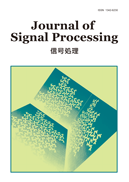All issues

Volume 19, Issue 1
Displaying 1-5 of 5 articles from this issue
- |<
- <
- 1
- >
- >|
-
2015Volume 19Issue 1 Pages 1
Published: January 25, 2015
Released on J-STAGE: January 25, 2015
JOURNAL FREE ACCESSDownload PDF (875K) -
Akira Taguchi2015Volume 19Issue 1 Pages 3-14
Published: January 25, 2015
Released on J-STAGE: January 25, 2015
JOURNAL FREE ACCESSIt is necessary to understand a human visual system and characteristics to develop image processing methods in accordance with human sense. In addition, various image processing methods that can simulate the human visual system have been proposed. In this paper, typical image processing methods that considered the human visual characteristics and simulated the human visual system are introduced. This paper consists of two parts. In the first part, we explain the mechanism and characteristics of human color sense. Furthermore, an image processing method that considered the characteristics of human color sense is explained. In the second part, automatic white balance adjustment and retinex processing methods, which can simulate the color and brightness constancy, are reviewed.View full abstractDownload PDF (2028K) -
Naoyori Matsuda, Kenji Suyama2015Volume 19Issue 1 Pages 15-25
Published: January 25, 2015
Released on J-STAGE: January 25, 2015
JOURNAL FREE ACCESSIn this paper, MUSIC (multiple signal classification) algorithm is applied for a sound source tracking using particle filters. MUSIC algorithm is a high-resolution sound source localization method but has high computational costs. Therefore, a reduction of computational cost is attempted by using the MUSIC spectrum function as a likelihood function of particle filters. When there are two sound sources, however, a particle intensification problem arises simultaneously. Therefore, a method to overcome this problem is also proposed. Several experimental results in a reverberant environment show that the proposed method can track two sound sources in real time.View full abstractDownload PDF (2095K) -
Tatsuji Tokiwa, Hiroshi Fukuda, Osamu Hiwaki2015Volume 19Issue 1 Pages 27-33
Published: January 25, 2015
Released on J-STAGE: January 25, 2015
JOURNAL FREE ACCESSWe investigate brain potentials related to the abandonment of the motor intention prior to movement in human volitional finger movement. Subjects are instructed to conduct a point-to-point finger reaching movement with the right index finger. The time to begin this movement is indicated with a clock making one revolution in 4 s. The time at which the clock hand passes the 3 o'clock position is adopted as the go-signal in the go task. In the series of trials, the pre-stop task is conducted with a red light-emitting diode stop-signal presented randomly at 0.1, 0.2, 0.3, 0.4, or 0.5 s before the go-signal. Cerebral potentials at the scalp are recorded using a 20-channel electroencephalography (EEG) system. In the go task without the stop-signal, clear movement-related cortical potentials are observed. In the pre-stop task with the stop-signal, the subjects are able to inhibit finger movement. A positive EEG potential distributed at the midline fronto-central scalp at 300-500 ms after the go-signal is observed only in the pre-stop task. This result suggests that the observed positive component is associated with the interruption of motor intention, as well as the revision of motor planning, in the motor cortices prior to the movement.View full abstractDownload PDF (993K) -
Atsushi Kajihara, Kentaro Yoshino, Tetsumi Harakawa, Shigeru Osawa2015Volume 19Issue 1 Pages 35-41
Published: January 25, 2015
Released on J-STAGE: January 25, 2015
JOURNAL FREE ACCESSMany manufacturers of wooden musical instruments attempt to evaluate timbre of musical instruments. Several quantitative evaluation methods for properties of timbre have been proposed recently. It is, however, difficult to quantify the subtle difference about sounds with musical instruments made of several types of material. In this paper, we develop an evaluation method using a sound waveform analysis. Our method enables us to classify the timbre properties of musical instruments. Finally, we confirmed the validity of our method based on the clustering by psychological evaluation.View full abstractDownload PDF (1101K)
- |<
- <
- 1
- >
- >|